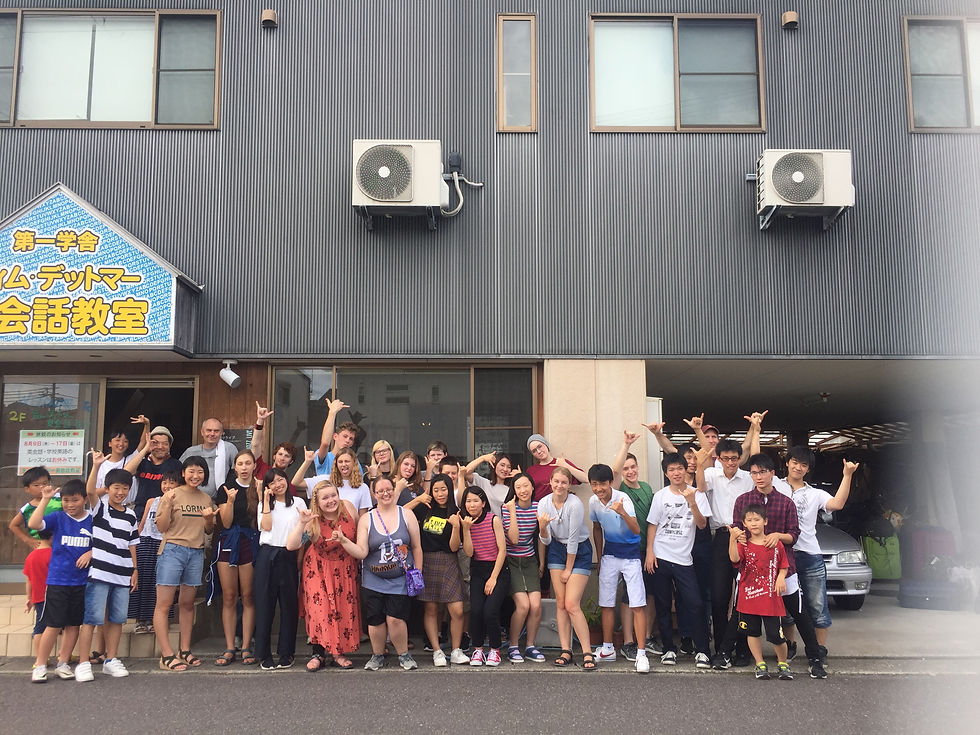Around the World and Back Again
- Asher Schleich
- Apr 12, 2019
- 3 min read

Throughout high school, we are presented with many beneficial experiences, though few can compare to a high school exchange program. The summer of 2018 brought about the 14th year of the Kettle Moraine Japanese exchange program. Students from Kettle Moraine School for Global Leadership and Innovation (KM Global) and Kettle Moraine School for Arts and Performance (KM Perform) traveled to Shingu, Japan in order to experience different cultures, and learn what life is like halfway around the world.
“The Shingu/Wisconsin Exchange Program began as a dream in my friend Tim's garage. We were hoping to find a way to build a bridge between Eastern and Western cultures,” Mr. Weber, head of the exchange, said when asked about the origins of the program. The opportunity to expand learning on a global scale has been

drawing students in for years. Junior Hunter Weber states, “I chose to go because the last time that I went, I had an amazing and life-changing experience, and wanted to replicate that as best I could.” Senior Makenna Boettcher, who hosted a Japanese student the previous summer, said, “I was a part of this trip last time and I made connections with people that I will remember for a lifetime.”

While we were in Japan, major holidays occured, giving us the opportunity to experience incredible festivals, including “Fire Festivals,” or firework shows. H. Weber says, “I enjoyed the finale of every single one I attended, but I found the open food bazaars very fun and interesting.” We were also able to visit many historical temples, monasteries, and shrines throughout the Wakayama Prefecture, in addition to Nachi No Taki, an active monastery with the tallest waterfall in Japan. “I've been to Nachi No Taki more than 20 times. Every time, I am struck by its natural beauty and the sense of calm I feel there,” says Mr. Weber. We then visited Kumano Hongu Taisha, a series of beautiful temples dedicated to a sun goddess and her family. “One thing that amazed me about the Kumano Hongu Taisha was the extravagance and detail of the shrines,” says junior Bethani Moore. Koya-San was next on the list of places to visit. Three hours and a long drive later, we reached the top of Mount Koya and its historical peak. It contains several temples, a monastery, and a cemetery that dates back a millenium.
During the exchange, we were offered many in-depth academic experiences at the locations we visited, though arguably some of the best experiences came from time spent with host families. We stayed with
Mr. Weber and Tim Detmer during the week, but on the weekends our host families were in charge of keeping us busy. Boettcher stated that her favorite thing to do with her host families was “everything.” She went on to add that meeting the extended family and close friends of her hosts was very impactful. With the hosts taking us in, we were able to get a glimpse into the daily life of a Japanese family: work, family dynamics, and

schooling. When asked about the differences between American and Japanese home life, H. Weber explained, “One difference I noticed was that the host mom did almost everything in terms of home life for the family, whereas in my home, it's more balanced.” Moore added, “The family wears different slippers for certain areas of the house. They have main slippers which replace their shoes when they enter the house, but then they have separate slippers for the bathroom.”

As a charter school, we are presented with unique opportunities that make us stand out in comparison to a traditional high school. For upperclassmen, this means a portfolio project, and some students utilized the trip to direct their projects. “My portfolio is based around my trip to Japan, the culture, and my experience. I was able to take a lot of pictures which I will use as references,” states Moore. She is using these photos to create a variety of drawings and other art pieces. Personally, I used the trip to develop the poetry and photography I will be using in my portfolio book.
Students were presented with many opportunities to grow throughout this trip. Not only did they gain knowledge of Japanese culture and history, but they also grew as people: “I learned that being confused in other countries is a fun experience, and making friends doesn't require a shared language,” H. Weber said. Mr. Weber even continues to learn from his experiences with Japanese culture, saying, “My interactions with Japanese culture has taught me to have a deep sense of gratitude for the many blessings I have in my life, from the clean water that flows from the faucet to the cool breeze that cools us off at the end of a long day.”














Comments